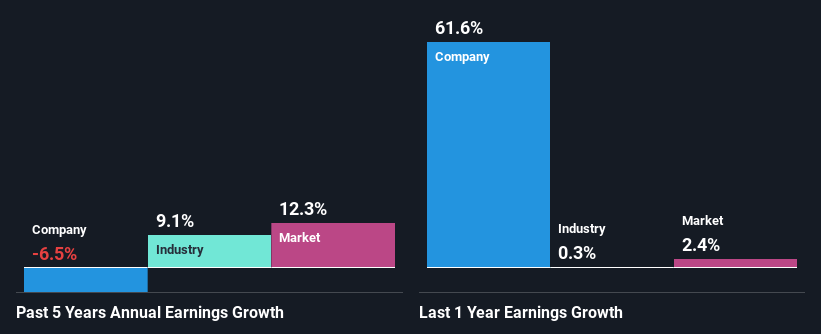Kossan Rubber Industries Bhd's (KLSE:KOSSAN) Stock Is Rallying But Financials Look Ambiguous: Will The Momentum Continue?
Kossan Rubber Industries Bhd (KLSE:KOSSAN) has had a great run on the share market with its stock up by a significant 21% over the last three months. However, we wonder if the company's inconsistent financials would have any adverse impact on the current share price momentum. In this article, we decided to focus on Kossan Rubber Industries Bhd's ROE.
Return on equity or ROE is a key measure used to assess how efficiently a company's management is utilizing the company's capital. In other words, it is a profitability ratio which measures the rate of return on the capital provided by the company's shareholders.
View our latest analysis for Kossan Rubber Industries Bhd
How Do You Calculate Return On Equity?
The formula for return on equity is:
Return on Equity = Net Profit (from continuing operations) ÷ Shareholders' Equity
So, based on the above formula, the ROE for Kossan Rubber Industries Bhd is:
1.8% = RM72m ÷ RM3.9b (Based on the trailing twelve months to March 2024).
The 'return' refers to a company's earnings over the last year. That means that for every MYR1 worth of shareholders' equity, the company generated MYR0.02 in profit.
Why Is ROE Important For Earnings Growth?
Thus far, we have learned that ROE measures how efficiently a company is generating its profits. Based on how much of its profits the company chooses to reinvest or "retain", we are then able to evaluate a company's future ability to generate profits. Assuming everything else remains unchanged, the higher the ROE and profit retention, the higher the growth rate of a company compared to companies that don't necessarily bear these characteristics.
Kossan Rubber Industries Bhd's Earnings Growth And 1.8% ROE
It is quite clear that Kossan Rubber Industries Bhd's ROE is rather low. Even compared to the average industry ROE of 8.6%, the company's ROE is quite dismal. Given the circumstances, the significant decline in net income by 6.5% seen by Kossan Rubber Industries Bhd over the last five years is not surprising. We believe that there also might be other aspects that are negatively influencing the company's earnings prospects. For instance, the company has a very high payout ratio, or is faced with competitive pressures.
So, as a next step, we compared Kossan Rubber Industries Bhd's performance against the industry and were disappointed to discover that while the company has been shrinking its earnings, the industry has been growing its earnings at a rate of 9.1% over the last few years.
The basis for attaching value to a company is, to a great extent, tied to its earnings growth. What investors need to determine next is if the expected earnings growth, or the lack of it, is already built into the share price. This then helps them determine if the stock is placed for a bright or bleak future. One good indicator of expected earnings growth is the P/E ratio which determines the price the market is willing to pay for a stock based on its earnings prospects. So, you may want to check if Kossan Rubber Industries Bhd is trading on a high P/E or a low P/E, relative to its industry.
Is Kossan Rubber Industries Bhd Using Its Retained Earnings Effectively?
Despite having a normal three-year median payout ratio of 48% (where it is retaining 52% of its profits), Kossan Rubber Industries Bhd has seen a decline in earnings as we saw above. So there could be some other explanations in that regard. For instance, the company's business may be deteriorating.
Moreover, Kossan Rubber Industries Bhd has been paying dividends for at least ten years or more suggesting that management must have perceived that the shareholders prefer dividends over earnings growth. Our latest analyst data shows that the future payout ratio of the company is expected to drop to 37% over the next three years. Accordingly, the expected drop in the payout ratio explains the expected increase in the company's ROE to 4.9%, over the same period.
Conclusion
Overall, we have mixed feelings about Kossan Rubber Industries Bhd. While the company does have a high rate of reinvestment, the low ROE means that all that reinvestment is not reaping any benefit to its investors, and moreover, its having a negative impact on the earnings growth. With that said, we studied the latest analyst forecasts and found that while the company has shrunk its earnings in the past, analysts expect its earnings to grow in the future. Are these analysts expectations based on the broad expectations for the industry, or on the company's fundamentals? Click here to be taken to our analyst's forecasts page for the company.
Have feedback on this article? Concerned about the content? Get in touch with us directly. Alternatively, email editorial-team (at) simplywallst.com.
This article by Simply Wall St is general in nature. We provide commentary based on historical data and analyst forecasts only using an unbiased methodology and our articles are not intended to be financial advice. It does not constitute a recommendation to buy or sell any stock, and does not take account of your objectives, or your financial situation. We aim to bring you long-term focused analysis driven by fundamental data. Note that our analysis may not factor in the latest price-sensitive company announcements or qualitative material. Simply Wall St has no position in any stocks mentioned.

 Yahoo Finance
Yahoo Finance 
